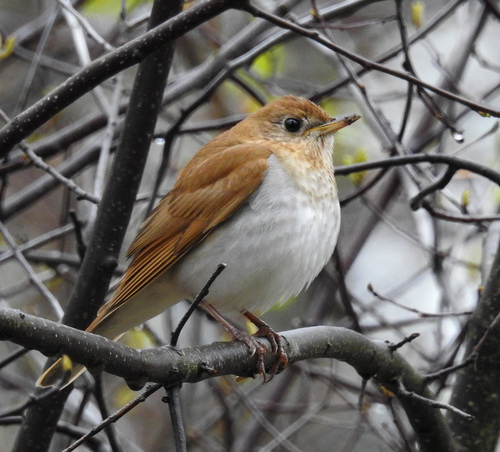
Veery
The Veery (*Catharus fuscescens*) is a small, North American thrush known for its ethereal, flute-like song, often described as a descending spiral. It plays a vital role in its forest ecosystem, primarily as an insectivore and seed disperser. While not globally threatened, it faces challenges due to habitat loss and fragmentation. The Veery holds a place in North American folklore and is often associated with twilight and the tranquility of deep woods.
16-19 cm
Length
26-30 cm
Wingspan
Least Concern
Conservation Status
Distribution
Breeds across southern Canada and the northern United States, extending south in the Appalachian Mountains. Winters in South America, primarily in the Amazon basin.
Lifespan
Typically 2-3 years in the wild, up to 10 years in captivity.
Veery's Habitat
Habitat Types
Deciduous forests, Mixed woodlands, Riparian areas
Climate Zones
Temperate, Boreal (breeding), Tropical (wintering)
Adaptations
Prefers dense understory for nesting and foraging, often near water sources. Their relatively long wings are adapted for long-distance migration.
Variations
Several subspecies are recognized, differing slightly in plumage and geographic range (e.g., *C. f. fuscescens*, *C. f. salicicolus*).
Appearance
Breeding Plumage
Generally uniform reddish-brown upperparts and pale underparts with faint spotting on the breast. No significant difference between breeding and non-breeding plumage.
Seasonal Feather Changes
No significant seasonal variation.
Sex Based Plumage Differences
Males and females are visually similar.
Notable Features
Reddish-brown upperparts, Faint, blurry spotting on the breast (less distinct than other thrushes), Relatively plain face with a weak eye-ring
Diet and Feeding
Primary Foods
Insects, Spiders, Fruits, Berries
Foraging Behavior
Forages primarily on the ground, flipping leaves and probing the soil. Also gleans insects from foliage and occasionally catches insects in flight.
Specializations
No highly specialized feeding adaptations.
Seasonal Diet Variations
Diet shifts from primarily insects during the breeding season to include more fruits and berries in the late summer and fall, fueling migration.
Behavior
Social Structure
Generally solitary or in pairs during the breeding season. May form small flocks during migration.
Communication
Distinctive, ethereal song (a descending series of flute-like notes), Call notes, including a 'veer' call that gives the bird its name, Chattering alarm calls
Migration
Nocturnal migrant. Travels long distances between North American breeding grounds and South American wintering grounds.
Territorial or Group Behaviors
Males defend breeding territories through song and chasing. Not known for strong group behaviors outside of migration.
Conservation
Threats
Habitat loss and fragmentation (both breeding and wintering grounds), Collisions with buildings and other structures during migration, Climate change (potential shifts in habitat suitability), Pesticide use in some areas
Protection Programs
Habitat conservation initiatives in key breeding and wintering areas, Efforts to reduce bird-building collisions
Local National Laws
Protected under the Migratory Bird Treaty Act in the United States and Canada.
Population Trend
Slightly Decreasing
Population Estimates
Global population estimated at 12 million.
Interesting Facts
The Veery's song is often described as sounding like "veer-veer-veer-veer," giving the bird its common name.
This onomatopoeic name reflects the bird's most characteristic vocalization.
They are one of the few North American songbirds to winter primarily in the Amazon basin.
This highlights their long-distance migratory capabilities.
Veeries are known to reuse nesting sites in subsequent years.
This behavior suggests a degree of site fidelity.
The Veery's diet includes a significant proportion of fruit, especially during migration, making it an important seed disperser.
This helps forest regeneration and plant diversity
Faqs about Veery
What does a Veery sound like?
The Veery has a beautiful, flute-like song that descends in pitch, often described as sounding like 'veer-veer-veer-veer'.
Where can I see a Veery?
Veeries are found in deciduous forests with dense undergrowth across southern Canada and the northern United States during the breeding season. They are most easily observed at dawn and dusk when they are most vocal.
Are Veeries endangered?
No, Veeries are currently listed as Least Concern by the IUCN, but their populations are facing some decline due to habitat loss and other threats.
How do I differentiate a Veery from other Thrush?
The Veery is identified by its uniform reddish-brown upperparts and faintly spotted breast, it has less prominent spotting than other thrushes like the Hermit or Swainson's Thrush.
Copyright @ Nature Style Limited. All Rights Reserved.
 English
English